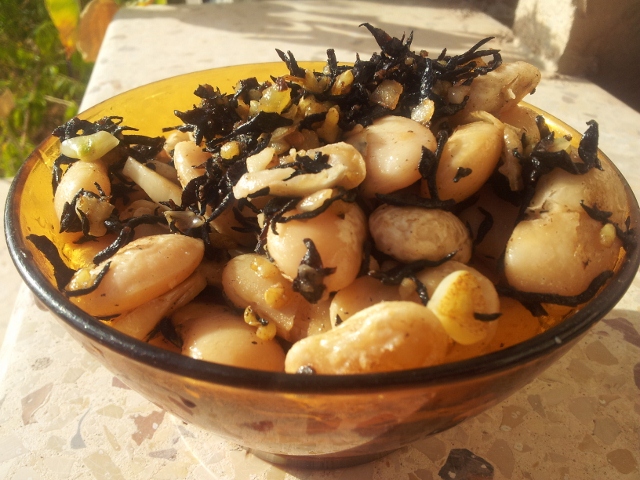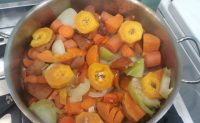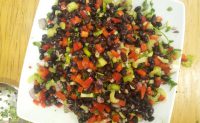Legumes, The Partners of Cereal Grains
Eyal Shpringer

Legumes are an essential family of plants for the living world of flora and fauna due to their ability to rehabilitate soils and enrich the ground with nitrogen. In natural habitats, they often grow near plants that consume nitrogen, such as herbaceous plants and cereal grains. As in nature, also in human nutrition, legumes are essential for health and combine excellently with cereal grains.
Throughout history, legumes were consumed mainly by poor people and animals because of their easy cultivation and ability to provide nutritional needs cheaply. The lack of animal protein intake and its replacement with other protein sources, such as combining grains and legumes, prevented poor peasants from those diseases caused by overly abundant and rich nutrition.
The Sprawling Legume in Relation to the Upright Grain
Legumes are considered a more primitive type of vegetation in relation to cereal grains. Their seeds are all arranged in one pod, unlike the more advanced cereal grains, which are organized in a separate package for each of the seeds.
Another difference between grains and legumes is their mode of reproduction: most legume plants reproduce through a colorful flower with an attractive appearance. Cereal grains, however, reproduce without using much temptation, simply by wind pollination.
Regarding plant structure, the cereal grains tend to stand upright thanks to their long and flexible stalk. In contrast to grains, many legumes tend to develop partnerships with neighboring plants, cling to plants and climb on them, or simply sprawl on the ground.
If we reflect momentarily on the differences, we can say that grain is more “serious,” more upright, and its leaves are sharp. Cereal grains are mainly oriented toward growing upwards as individuals that are parts of a collective numbering hundreds and thousands of similar plants.
Conversely, the legumes are more sensual, flowery, ancient, sprawling, and interested in one-on-one relationships. They create complex relationships with the plant and the animal world by pollinating insects and bacteria that help them fix nitrogen through the roots. their plump seeds contain more fat and protein in addition to carbohydrates, unlike cereal grains, which have mainly carbohydrates.
Cereal Grains Are Yang, While Legumes Are Yin
It can be said that a cereal grain is more yang: sharp, precise, modern, and contains a lot of Qi. The legume is more yin: scattered and sprawling, with many directions and varied qualities. On the plate, grain and legume complement each other, support each other, and influence us with their unique qualities.
Nutritional Benefits
Legumes are rich in protein and certain nutrient compounds that can help create complete protein similar to those found in animal-based proteins. They have a high fat and carbohydrate content. They also contain high levels of iron, calcium, potassium, phosphorus, and several B vitamins. Legumes sprout quickly in the spring. Sprouting enriches them with vitamin C and enzymes. Legumes are essential for brain and body development, blood sugar, and fluid balance.
Unique Effects
Chinese medicine generally attributes legumes to the kidney organ and the water element. Still, other categorizing systems, such as the five-element model, attribute each of them to a particular season according to its color and external appearance.
Most legumes except soy have a drying and astringing effect (Ayurveda describes legumes as increasing “vata” – a tendency associated with wind and dryness). Some experience this quality as difficulty digesting legumes, gas, and bloating.
Legumes contain oligosaccharides whose enzymes needed to break them down are only found in healthy intestines. When digestion is weak, these enzymes are not present, and then there is difficulty digesting them. The following methods help cope with this digestive difficulty and help incorporate this important food into the diet:
Cooking Legumes in Ways that Reduce Their Drying Effect
Like any complex and unique lady, legumes must be adequately cared for. If we do not respect them, the relationship with the grain partner will end in a very unpleasant bowel upset. There are several proven effective methods for treating legumes. Depending on the diner’s sensitivity level, you can try all or some of them.
Using Oil: In all cultures where legumes are commonly eaten, such as the Middle East (tahini, olive oil) or Mexico (frying beans), they are combined with oil.
Dosaging: A person not used to eating legumes should start with small daily amounts, preferably at the beginning of the day until noon (the hours of the spleen-pancreas and stomach, according to Chinese medicine). Eating legumes in small amounts will allow the body to learn to produce appropriate enzymes to digest them. Remember that even a small amount of legumes at each meal has a therapeutic effect, and you do not need to overdo it.
Thorough Chewing: Thorough chewing allows the digestive enzymes in saliva to start the digestion process already in the mouth and improves the continued digestion of legumes in the intestines.
Introducing Legumes to Children: Avoid giving legumes to young children under 18 months old. The dry and difficult-to-digest legumes are unsuitable for the infant’s immature digestive system.
Choosing the Right Legume: The easiest legumes to digest in order are lentils, mung beans, chickpeas, and azuki beans, then kidney beans and hummus, with soybeans and their varieties in the last place. Note that processed soy products such as tofu, miso, soy sauce, soy milk, and tempeh are actually easy to digest.
Soaking/Sprouting: Soften the Legume – When sprouting the legume, its nutrients become more bioavailable to the body and easier to digest. To reduce the chance of digestive problems, discard the soaking water. In legumes like azuki, the soaking liquid contains pigments and vital substances, and therefore, consideration should be given as to whether to discard the liquids in this case. Sprouting is more common in spring and summer and is more recommended for heat and excess conditions.
Cooking in the Double Boiling Method: This cooking method greatly softens the legume and makes it easier to digest. Bring the legumes to a boil in a pot with water. As the water level goes down due to evaporation, gently add some lukewarm water to restore the liquids lost during cooking. Repeat the process at least twice or three times.
Combinations: Legumes combine best with non-starchy vegetables and seaweeds. Combining with grains is recommended to achieve complete protein, but people with very weak digestion will struggle to accept this combination.
Salt: Salt should be added towards the end of cooking. This way, the salt can act as a messenger that delivers the qi of the legume to the kidneys. The salt improves the digestion of the legume. However, avoid adding salt in the initial cooking stages, as this causes the skin to harden, making digestion more difficult.
Spices: Cumin, fennel, ginger, ajwain, anise, and turmeric are common spices for reducing gas produced from legume digestion. Mexicans use a freshly picked plant called epazote (Chenopodium ambrosioides) to achieve the same effect.
Adding Seaweeds: Kombu or kelp seaweed placed at the bottom of the pot when cooking legumes helps soften them and also enriches the dish with minerals.
After Boiling: It is advisable to leave the lid open for 20 minutes and remove the foam, which helps eliminate most sugars that hinder digestion.
Adding Acidity: Adding a little acidity to legumes in the form of quality vinegar can help in severe cases of difficulty digesting legumes.
For advanced householders, legumes can also be cooked in a pressure cooker, which shortens cooking time and softens them. The only disadvantage of this method is that it is difficult to cook them “one by one” in this way.
Eyal Shpringer is a Chinese medicine practitioner and a clinical herbalist specializing in Chinese nutrition and traditional nutritional approaches. Eyal holds a master’s degree in research of East Asian medicines. Since 2007, he has been teaching a postgraduate training program in Chinese and oriental nutrition according to the TEF method and other courses and workshops for practitioners. Eyal co-authored the bestselling book Cooking for Life: A Traditional Nutrition Cookbook for Cancer Patients (Hebrew).
Did you find the recipe interesting? Do you want to continue studying with me?
You are invited to join me on my Instagram page and the Traditional Nutrition and Medicine Facebook group.


